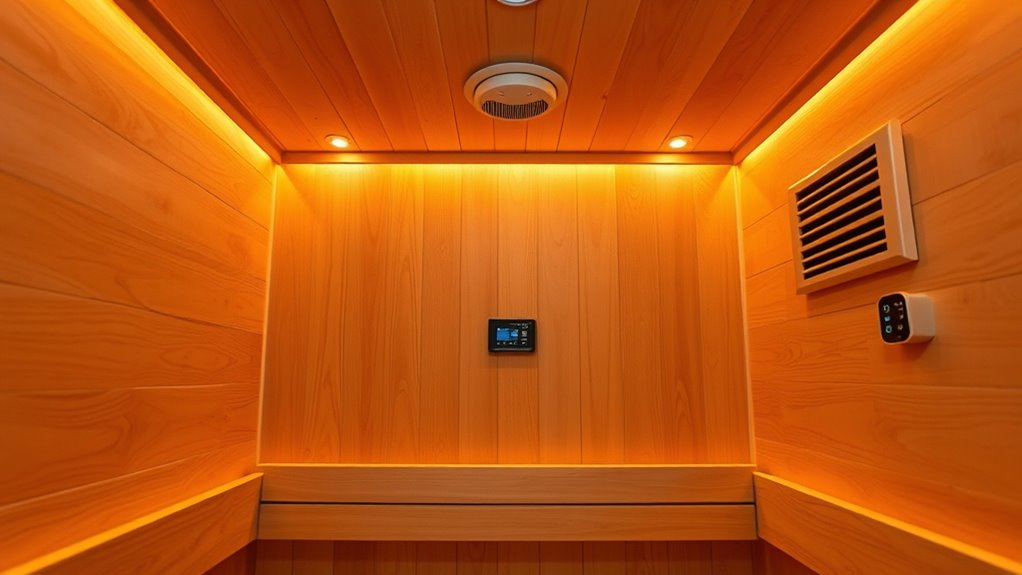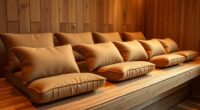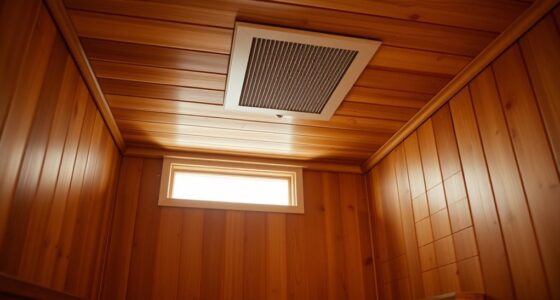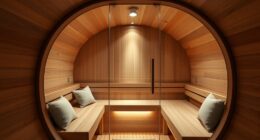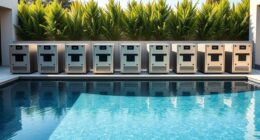To master sauna ventilation in a weekend, focus on understanding airflow basics and component placement. Install intake vents near the floor and exhaust vents near the ceiling on opposite sides to promote natural circulation. Keep vents unobstructed and use durable, heat-resistant materials. Regularly inspect and clean your system, and follow safety guidelines for electrical wiring. For detailed tips on optimizing airflow and safety, keep exploring how each part works together for a healthy sauna environment.
Key Takeaways
- Prioritize proper vent placement: intake near the floor and exhaust near the ceiling to promote effective airflow.
- Choose durable, heat-resistant vents and fans suited for small sauna spaces, ensuring optimal airflow capacity.
- Regularly inspect, clean, and maintain vents and filters to prevent obstructions and ensure efficient ventilation.
- Ensure electrical safety by turning off power during installation, using waterproof components, and following local codes.
- Use humidity sensors or thermostats to monitor conditions and automatically adjust ventilation for consistent air quality.
Why Is Ventilation Important in Small Sauna Spaces?

Proper ventilation is essential in small sauna spaces because it guarantees fresh air circulates effectively, preventing the buildup of harmful fumes and excess humidity. Without proper airflow, humidity can rise quickly, making the environment uncomfortable and increasing the risk of mold and mildew. Good ventilation supports humidity control, ensuring the air remains balanced and prevents dampness from damaging surfaces. Additionally, it promotes air purification, removing stale air and unpleasant odors, which helps you breathe easier during your sauna session. Proper airflow also helps regulate temperature, making the experience safer and more enjoyable. In small saunas, effective ventilation isn’t just a luxury—it’s a necessity for maintaining a healthy, comfortable, and hygienic space. Incorporating the right air exchange rate ensures consistent airflow and optimal sauna conditions.
What Are the Key Components of Sauna Ventilation Systems?

A well-designed sauna ventilation system relies on several key components working together to guarantee effective airflow and humidity control. The main parts include vents, exhaust fans, and intake openings, which facilitate proper air exchange. Proper air exchange removes excess humidity and stale air, maintaining comfort and safety. You also need a thermostat or humidity sensor to monitor conditions and adjust airflow accordingly. These components work simultaneously to prevent mold, control humidity levels, and ensure fresh air circulation. Incorporating proper placement of vents is essential to optimize airflow and efficiency throughout the space.
How Do I Choose the Right Vents and Exhausts for My Sauna?

Choosing the right vents and exhausts for your sauna is essential to guarantee effective airflow and humidity control. Focus on ventilation design to ensure proper air exchange, preventing stuffiness and moisture buildup. When selecting vents, consider size, placement, and airflow capacity to match your sauna’s dimensions and heating source. Vent material selection also matters; durable, heat-resistant materials like stainless steel or high-quality plastics withstand high temperatures and humidity. Avoid flimsy or metal vents that may warp or corrode over time. Properly designed vents should promote steady airflow, reducing condensation and maintaining a comfortable environment. Take the time to research different vent options and consult manufacturer guidelines to ensure your system is optimized for safety, efficiency, and long-term durability. Additionally, understanding ventilation principles can help you achieve optimal air circulation and moisture management in your sauna.
Where Should I Place Vents for Optimal Airflow?
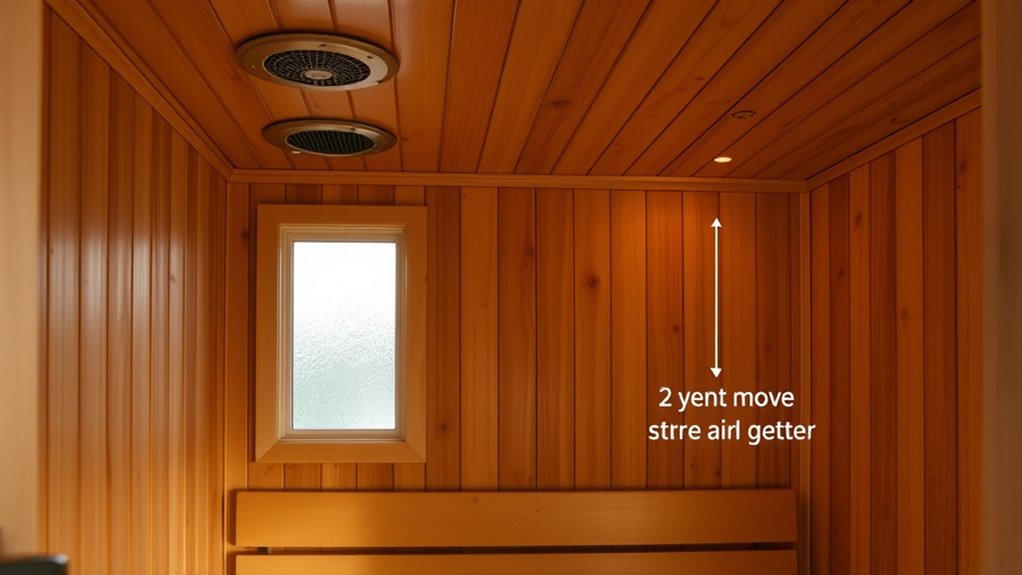
To achieve ideal airflow in your sauna, you should strategically place vents to promote efficient air exchange. Proper venting placement is key to airflow optimization. Position the intake vent near the floor on one side of the sauna to draw in cool, fresh air. The exhaust vent should go near the ceiling on the opposite side to allow warm, stale air to escape naturally. This setup encourages a steady current, ensuring fresh air circulates throughout the space. Keep vents unobstructed and avoid placing them directly above or below heat sources, which can disrupt airflow. Additionally, using ventilation accessories can further improve airflow efficiency. By carefully considering venting placement, you create a balanced airflow system that maintains comfort, reduces humidity, and prevents stuffiness. Proper vent placement makes your sauna healthier and more enjoyable.
How Can I Maintain and Troubleshoot My Sauna Ventilation?
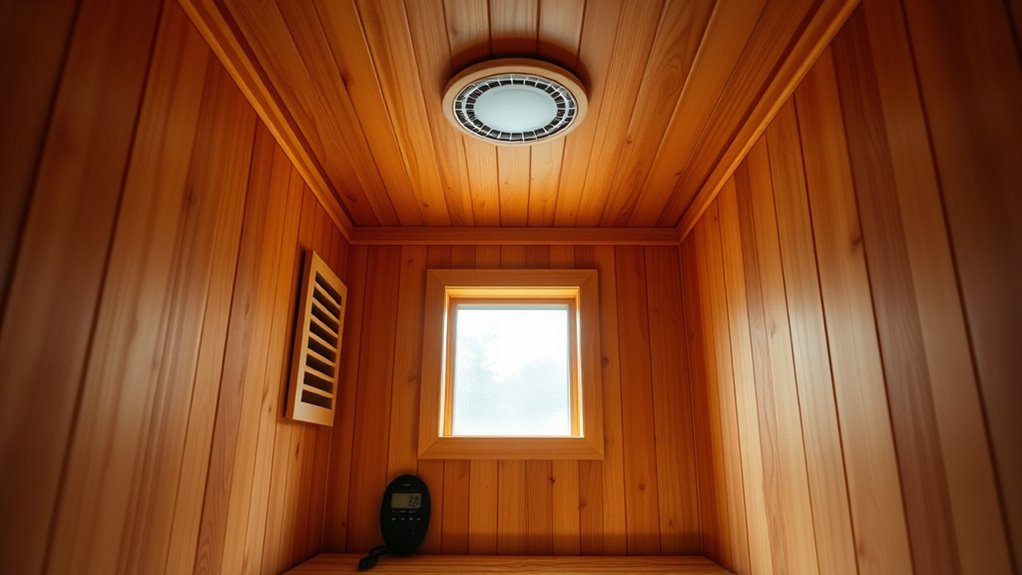
Regular maintenance is essential to keep your sauna ventilation working effectively. Start by inspecting your air filters regularly; clean or replace them to ensure proper airflow. Check for dust or debris buildup around vents and clear any obstructions. Upgrading your ventilation system can improve efficiency, especially if you notice persistent issues. Troubleshoot by listening for unusual noises or uneven airflow, which may indicate a malfunction. Use the table below for quick guidance:
| Issue | Solution | When to Seek Help |
|---|---|---|
| Poor airflow | Clean or replace filters | After cleaning, if issues persist |
| Unusual noises | Tighten loose components | If noise continues after tightening |
| Inconsistent ventilation | Check duct connections | If problem persists after adjustments |
| Overheating system | Upgrade to better fans or vents | If frequent overheating occurs |
| System not turning on | Inspect wiring and switches | If wiring is intact, call a professional |
Additionally, understanding the importance of somatic therapy techniques can help you better manage stress and maintain a sense of well-being, even during sauna use.
Are There Any Safety Tips to Keep in Mind During Installation?

When installing your sauna ventilation, make sure to leave proper clearance around vents and ducts to prevent issues later. Always wear protective gear, like gloves and goggles, to stay safe during the process. Don’t forget to verify electrical safety by turning off power and checking connections before you start working.
Proper Ventilation Clearance
Ensuring proper ventilation clearance during installation is essential for safety and ideal sauna performance. You need to pay attention to airflow patterns to prevent hot spots and guarantee even heat distribution. Follow ventilation standards to determine the correct distances between vents, walls, and other structures. Maintaining adequate clearance allows fresh air to circulate effectively and prevents moisture buildup, which could lead to mold or wood damage. Be cautious not to block vents or obstruct airflow paths, as this can compromise safety and sauna function. Double-check measurements and placement to guarantee vents are positioned correctly for optimal airflow. Proper clearance not only enhances safety but also promotes efficient ventilation, making your small sauna room more comfortable and longer-lasting. Understanding ventilation is crucial for maintaining a safe and effective sauna environment.
Use Protective Gear
Using protective gear during installation is vital to safeguard yourself from potential hazards. Wear protective clothing to shield your skin from sharp edges, splinters, or hot surfaces. Safety gloves are indispensable when handling tools or working with electrical components, preventing cuts and shocks. Always choose gear that fits well and is designed for construction or electrical work. Keep your protective equipment on throughout the installation process to minimize risks. Additionally, verify your gear is in good condition—discard any torn gloves or damaged clothing. Remember, safety gear isn’t just a formality; it’s a key barrier against injuries. Taking these precautions helps you work efficiently while reducing the chance of accidents or injuries during your sauna ventilation project. Studies show that home security systems significantly increase safety during home improvement tasks.
Verify Electrical Safety
Before starting your sauna ventilation installation, confirming electrical safety is vital to prevent accidents. First, switch off the power and use a voltage tester to verify circuits are de-energized. Check that all wiring is properly grounded, especially around components involved in humidity control and air filtration. Use waterproof, heat-resistant connectors and enclosures to avoid shorts caused by moisture. Keep electrical components away from water sources and guarantee proper insulation. Inspect all connections regularly for signs of wear or corrosion. Proper electrical safety reduces the risk of shocks and fire hazards, allowing you to focus on maintaining ideal humidity control and air filtration. Always follow local electrical codes and, if unsure, consult a professional to guarantee a safe, efficient installation.
Frequently Asked Questions
Can I Upgrade My Sauna Ventilation System Later?
Yes, you can upgrade your sauna ventilation system later. Many believe ventilation myths, but improving airflow optimization is always feasible with the right modifications. You might add a more powerful exhaust fan or adjust existing vents to enhance airflow. Just guarantee your upgrades align with your sauna’s size and design. Consulting a professional can help you make the best choices, ensuring your ventilation system functions efficiently and safely over time.
How Does Humidity Affect Sauna Ventilation Efficiency?
Humidity plays a vital role in sauna ventilation efficiency; high humidity can hinder airflow dynamics, making it harder for fresh air to circulate and remove excess moisture. Conversely, low humidity enhances humidity control and promotes better ventilation. When humidity levels are balanced, your sauna’s airflow works seamlessly, ensuring comfort and safety. Proper ventilation adapts to humidity fluctuations, maintaining ideal conditions and preventing issues like mold or stale air buildup.
Are There Eco-Friendly Ventilation Options for Saunas?
Yes, there are eco-friendly ventilation options for saunas. You can choose systems made from sustainable materials that reduce environmental impact, such as bamboo or recycled metals. Eco ventilation solutions, like natural airflow designs or solar-powered fans, help you maintain good air quality while conserving energy. By opting for these sustainable options, you guarantee your sauna remains eco-conscious without sacrificing ventilation efficiency.
What Are Common Signs of Poor Ventilation in a Sauna?
You notice poor airflow, excessive humidity, or lingering odors, which are signs of poor ventilation. These issues hinder airflow optimization and can make your sauna uncomfortable or unsafe. If you experience these symptoms, it’s time for ventilation troubleshooting. Check for blockages, ensure vents are clear, and consider upgrading your ventilation system. Proper airflow is key to maintaining a healthy, enjoyable sauna environment, so address these signs promptly.
How Long Does Installation of Advanced Ventilation Systems Typically Take?
Installing advanced ventilation systems might seem intimidating, but it usually takes about one to two days. You’ll focus on proper ventilation design and airflow optimization to guarantee your sauna stays comfortable and efficient. While some worry about disruptions, proper planning minimizes downtime. With skilled installation, you’ll enjoy improved air quality quickly, enhancing your sauna experience without extended delays. You get better ventilation faster, making your space healthier and more enjoyable.
Conclusion
Mastering sauna ventilation is like opening a treasure chest—you’ll enjoy safer, more comfortable sessions. By understanding key components, proper placement, and maintenance, you guarantee your sauna remains a haven of relaxation. Think of it as tending a delicate garden; with care and attention, your sauna will flourish. So, take these tips to heart and turn your small space into a sanctuary where airflow flows as smoothly as a gentle breeze on a summer day.
